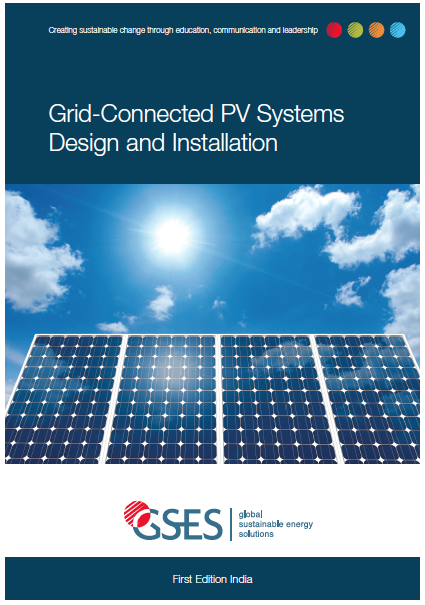BooksThis comprehensive training handbook provides detailed technical information and step-by-step methodology for designing a grid-connected photovoltaic (PV) system. The book covers the fundamentals of solar PV systems, the different components required and the need to match them, and how to size a system for optimum production. It also includes methods for conducting site surveys of potential installations, system installation, troubleshooting, maintenance and the economics of grid-connected PV systems. The handbook is designed around relevant Indian and international standards relating to grid-connected solar systems. You can purchase a copy of the Grid-Connected PV Systems: Design and Installation handbook in the GSES Shop.

Table of Contents
- Introduction
- Occupational Health & Safety
- Electrical Basics
- Solar Radiation
- Series and Parallel Circuits
- PV Cells
- Inverters
- Mounting Systems
- Balance of System
- 9. Energy Efficiency
- Site Assessment
- Matching Array and Inverter
- System Protection
- Cable Sizing
- Losses in GC PV Systems
- System Yield and Performance
- System Installation
- System Commissioning
- Maintenance and Troubleshooting
- Large PV Systems
- Economics of Grid Connected Systems
- Smart Grids
The handbook has 21 topics presented so that trainees learn and practice all aspects of designing grid-connected solar systems. Topics contain illustrative reading materials, worked examples for study, and exercises for practice.
Book Description
The first few topics of the book are designed to help readers understand the fundamentals of PV installation. These include solar irradiation, peak sun hours, sun-path diagrams, the position of the sun, solar altitude, geometric effects, tilting solar modules, electrical integration of PV modules and configuration of the array. Types and characteristics of solar cells, including power characteristics, performance, electrical protection and reliability issues, are discussed in detail, providing essential engineering and scientific knowledge to the designers. There is also a topic on inverters, which covers inverter types, efficiencies, protection systems, power quality, monitoring and selection.
The highly illustrative topic on mounting structures covers different types of mounting systems suitable for different types of roofing and ground material, PV array row spacing and calculating wind loading for solar arrays in different regions of India.
The book covers designing, selecting and balancing system components, including DC and AC cabling, protection and disconnection switches (fuses, isolators and/or circuit breakers), lightning protection, PV array DC and inverter AC isolators, metering and system monitoring.
A step-by-step methodology is provided for undertaking a site assessment to determine energy-efficient initiatives, occupational health and safety risks, solar radiation and shading, how the PV modules will be mounted, the positioning of inverters and the cable layout.
Matching of array and inverter is of the utmost importance for better performance of a grid-connected PV system. The designer needs to ensure that these components match in terms of voltage, current and power during seasonal changes in the operating temperature of the solar array. The handbook covers this aspect with several working examples and case studies.
The book meticulously covers the forms of protection used within a PV array, the method of determining whether fault current protection is required and the sizing of fault current protection. Similarly, sizing and selection of DC and AC cabling is also explained, with several working examples.
In evaluating the energy yield and performance ratio of a PV system, it is important to consider losses from various different factors, including temperature, soiling, shading, manufacturer’s tolerance, voltage drop through AC and DC cabling, inverter, tilt and orientation of the solar modules.
The chapter on large grid-connected PV systems provides a valuable insight into the key issues when designing MW-scale systems. Systematic design methodology and key considerations have been presented in a simple and comprehensive manner for in-depth understanding.
The Grid-Connected PV Systems: Design and Installation handbook is a complete reference solution for industry designers and PV professionals. GSES also offers a complete training course on Grid-Connected PV System Design for individuals looking to start their career in this industry or to build on their existing knowledge. Click here to learn more about the training program.


